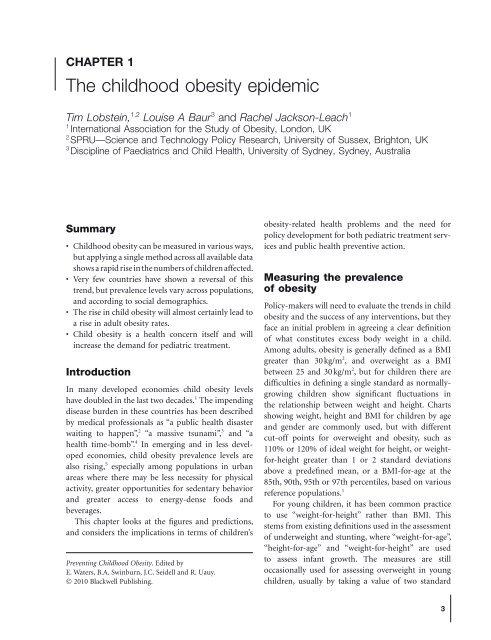Preventing Childhood Obesity - Evidence Policy and Practice.pdf
Preventing Childhood Obesity - Evidence Policy and Practice.pdf
Preventing Childhood Obesity - Evidence Policy and Practice.pdf
You also want an ePaper? Increase the reach of your titles
YUMPU automatically turns print PDFs into web optimized ePapers that Google loves.
CHAPTER 1<br />
The c hildhood o besity e pidemic<br />
Tim Lobstein, 1,2 Louise A Baur 3 <strong>and</strong> Rachel Jackson - Leach 1<br />
1 International Association for the Study of <strong>Obesity</strong>, London, UK<br />
2 SPRU — Science <strong>and</strong> Technology <strong>Policy</strong> Research, University of Sussex, Brighton, UK<br />
3 Discipline of Paediatrics <strong>and</strong> Child Health, University of Sydney, Sydney, Australia<br />
Summary<br />
• <strong>Childhood</strong> obesity can be measured in various ways,<br />
but applying a single method across all available data<br />
shows a rapid rise in the numbers of children affected.<br />
• Very few countries have shown a reversal of this<br />
trend, but prevalence levels vary across populations,<br />
<strong>and</strong> according to social demographics.<br />
• The rise in child obesity will almost certainly lead to<br />
a rise in adult obesity rates.<br />
• Child obesity is a health concern itself <strong>and</strong> will<br />
increase the dem<strong>and</strong> for pediatric treatment.<br />
Introduction<br />
In many developed economies child obesity levels<br />
have doubled in the last two decades. 1 The impending<br />
disease burden in these countries has been described<br />
by medical professionals as “ a public health disaster<br />
waiting to happen ”, 2 “a massive tsunami ” ,3 <strong>and</strong> “ a<br />
health time - bomb ”. 4 In emerging <strong>and</strong> in less developed<br />
economies, child obesity prevalence levels are<br />
also rising, 5 especially among populations in urban<br />
areas where there may be less necessity for physical<br />
activity, greater opportunities for sedentary behavior<br />
<strong>and</strong> greater access to energy - dense foods <strong>and</strong><br />
beverages.<br />
This chapter looks at the figures <strong>and</strong> predictions,<br />
<strong>and</strong> considers the implications in terms of children ’ s<br />
<strong>Preventing</strong> <strong>Childhood</strong> <strong>Obesity</strong>. Edited by<br />
E. Waters, B.A. Swinburn, J.C. Seidell <strong>and</strong> R. Uauy.<br />
© 2010 Blackwell Publishing.<br />
obesity - related health problems <strong>and</strong> the need for<br />
policy development for both pediatric treatment services<br />
<strong>and</strong> public health preventive action.<br />
Measuring the p revalence<br />
of o besity<br />
<strong>Policy</strong> - makers will need to evaluate the trends in child<br />
obesity <strong>and</strong> the success of any interventions, but they<br />
face an initial problem in agreeing a clear definition<br />
of what constitutes excess body weight in a child.<br />
Among adults, obesity is generally defined as a BMI<br />
greater than 30 kg/m 2 , <strong>and</strong> overweight as a BMI<br />
between 25 <strong>and</strong> 30 kg/m 2 , but for children there are<br />
difficulties in defining a single st<strong>and</strong>ard as normally -<br />
growing children show significant fluctuations in<br />
the relationship between weight <strong>and</strong> height. Charts<br />
showing weight, height <strong>and</strong> BMI for children by age<br />
<strong>and</strong> gender are commonly used, but with different<br />
cut - off points for overweight <strong>and</strong> obesity, such as<br />
110% or 120% of ideal weight for height, or weight -<br />
for - height greater than 1 or 2 st<strong>and</strong>ard deviations<br />
above a predefined mean, or a BMI - for - age at the<br />
85th, 90th, 95th or 97th percentiles, based on various<br />
reference populations. 1<br />
For young children, it has been common practice<br />
to use “weight-for-height ” rather than BMI. This<br />
stems from existing definitions used in the assessment<br />
of underweight <strong>and</strong> stunting, where “weight-for-age ” ,<br />
“height-for-age ” <strong>and</strong> “weight-for-height ” are used<br />
to assess infant growth. The measures are still<br />
occasionally used for assessing overweight in young<br />
children, usually by taking a value of two st<strong>and</strong>ard<br />
3

















